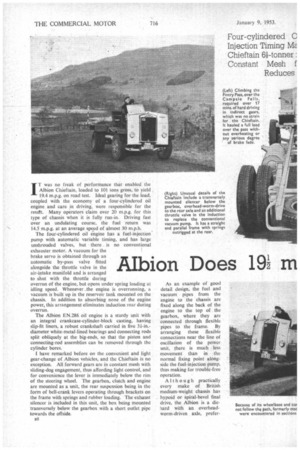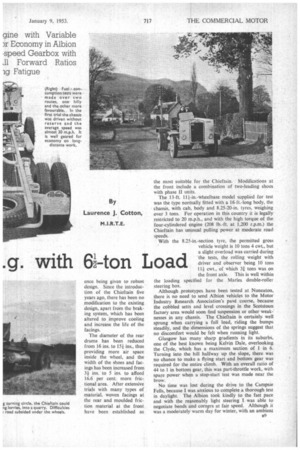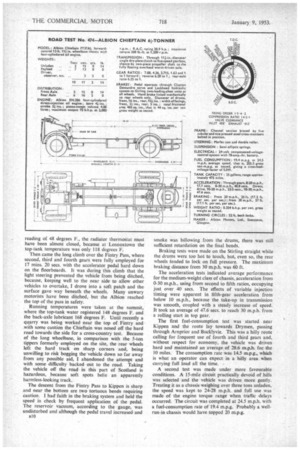Albion Does 19 m
Page 42

Page 43

Page 44

If you've noticed an error in this article please click here to report it so we can fix it.
.g. with 6-ton Load By Laurence J. Cotton, M.I.R.T.E. IT was no freak of performance that enabled the Albion Chieftain, loaded to 101 tons gross, to yield 19.4 m.p.g. on road test. Ideal gearing for the load, coupled with the economy of a four-cylindered oil engine and care in driving, were responsible for the result. Many operators claim over 20 m.p.g. for this type of chassis when it is fully run-in. Driving fast over an undulating course, the fuel return was 14.5 m.p.g. at an average speed of almost 30 m.p.h. The four-cylindered oil engine has a fuel-injection* pump with automatic variable timing, and has large unshrouded valves, but there is no conventional
exhauster motor. A vacuum for the brake servo is obtained through an automatic by-pass valve fitted alongside the throttle valve in the air-intake manifold and is arranged to shut with the throttle during overrun of the engine, but opens under spring loading at idling speed. Whenever the engine is overrunning, a vacuum is built tip in the reservoir tank mounted on the chassis. In addition to absorbing none of the engine power, this arrangement eliminates induction roar during overrun.
The Albion EN.286 oil engine is a sturdy unit with an integral crankcase-cylinder-block casting, having slip-fit liners, a robust crankshaft carried in five 3-in.diameter white-metal-lined bearings and connecting rods split obliquely at the big-ends, so that the piston and connecting-rod assemblies can be removed through the cylinder bores.
I have remarked before on the convenient and light gear-change of Albion vehicles, and the Chieftain is no exception. All forward gears are in constant mesh with sliding-dog engagement, thus affording light control, and for convenience the lever is immediately below the rim of the steering wheel. The gearbox, clutch and engine are mounted as a unit, the rear suspension being in the form of bell-crank levers operating through brackets on the frame with springs and rubber loading. The exhaust silencer is included in this unit, the box being mounted transversely below the gearbox with a short outlet pipe towards the offside. As an example of good detail design, the fuel and vacuum • pipes from the engine to the chassis are fixed along the back of the engine to the top of the gearbox, where they are connected through flexible pipes to the frame. By arranging these flexible connections near the line of oscillation of the power unit, there is much less movement than in the normal fixing point alongside the fuel-injection pump, thus making for trouble-free operation.
Although practically every make of British medium-weight chassis has hypoid or spiral-bevel final drive, the Albion is a diehard with an overheadworm-driven axle, prefer ence being given to robust design. Since the introduction of the Chieftain five years ago, there has been no modification to the existing design, apart from the braking system, which has been altered to improve cooling and increase the life of the facings.
The diameter of the rear drums has been reduced from 16 ins. to 151 ins., thus providing more air space inside the wheel, and the width of the shoes and facings has been increased from 3} ins. to 5 ins, to afford 16.6 per cent. more frictional area. After extensive trials with many types of material, woven facings at the rear and moulded friction material at the front have been established as
the most suitable for the Chieftain. Modifications at the front include a combination of two-leading shoes with phase II units.
The 13-ft. 11 l-in.-wheelbase model supplied for test was the type normally fitted with a 16-ft.-long body, the chassis, with cab, body and 8.25-20-in. tyres, weighing over 3 tons. For operation in this country it is legally restricted to 20 m.p.h., and with the high torque of the four-cylindered engine (208 lb.-ft. at 1,200 r.p.m.) the Chieftain has unusual pulling power at moderate road speeds.
With the 8.25-in.-section tyre, the permitted gross vehicle weight is 10 tons 4 cwt., but a slight overload was carried during the tests, the rolling weight with driver and observer being 10 tons 11 cwt., of which 3* tons was on the front axle. This is well within the loading specified for the Marks double-roller steering box.
Although .prototypes have been tested at Nuneaton, there is no need to send Albion vehicles to the Motor Industry Research Association's pave course, because the cobbled setts and level crossings in the Scotstoun factory area would soon find suspension or other weaknesses in any chassis. The Chieftain is certainly well sprung when carrying a full load, riding the bumps steadily, and the dimensions of the springs suggest that no discomfort would be felt when running light.
Glasgow has many sharp gradients in its suburbs, one of the best known being Kelvin Dale, overlooking the Clyde, which has a maximum section of 1 in 6. Turning into the hill halfway up the slope, there was no chance to make a flying start and bottom gear was required for the entire climb. With an overall ratio of 44 to 1 in bottom gear, this was part-throttle work, with spare power when a stop-start test was made near the brow.
No time was lost during the drive to the Catnpsie Fells, because I was anxious to complete a thorough test in daylight. The Albion took kindly to the fast pace and with the reasonably light steering I was able to negotiate bends and corners at fair speed. Although it was a moderately warm day for winter, with an ambient reading of 48 degrees F., the radiator thermostat must have been almost closed, because at Lennoxtown the toptank temperature was only 118 degrees F.
Then came the long climb over the Fintry Pass, where second, third and fourth gears were fully employed for 17 mins. 20 secs. with the accelerator pedal hard down on the floorboards. It was during this climb that the light steering prevented the vehicle from being ditched, because, keeping well to the near side to allow other vehicles to overtake, I drove into a soft patch and the surface gave way beneath the wheels. Many unwary motorists have been ditched, but the Albion reached the top of the pass in safety.
Running temperatures were taken at the summit, where the top-tank water registered 148 degrees F. and the back-axle lubricant 168 degrees F. Until recently a quarry was being worked near the top of Fintry and with some caution the Chieftain was nosed off the hard road towards the side for a cross-country test. Because of the long wheelbase, in comparison with the 5-ton tippers formerly employed on the site, the rear wheels left the hard track on sharp corners and, being unwilling to risk bogging the vehicle down so far away from any possible aid, I abandoned the attempt and with some difficulty backed out to the road. Taking the vehicle off the road in this part of Scotland is hazardous, because soft spots belie an apparently harmless-looking track.
The descent from the Fintry Pass to Kippen is sharp and near the bottom are two tortuous bends requiring caution. I had faith in the braking system and held the speed in check by frequent application of the pedal. The reservoir vacuum, according to the gauge, was undisturbed and although the pedal travel increased and slO smoke was billowing from the drums, there was still sufficient retardation on the final bends.
Braking tests were made on the Stirling straight while the drums were too hot to touch, but, even so, the rear wheels tended to lock on full pressure. The maximum braking distance from 30 m.p.h. was 60 ft.
The acceleration tests indicated average performance for the medium-weight class of chassis, acceleration from 0-30 m.p.h., using from second to fifth ratios, occupying just over 40 secs. The effects of variable injection timing were apparent in fifth-gear acceleration from below 10 m.p.h., because the take-up in transmission was smooth, coupled with a steady increase of speed. It took an average of 47.6 secs. to reach 30 m.p.h. from a rolling start in top gear.
The first fuel-consumption test was started near Kippen and the route lay towards Drymen, passing through Arnprior and Bucklyvie. This was a hilly route calling for frequent use of fourth and third gears and, without respect for economy, the vehicle was driven hard and maintained an average of 28.6 m.p.h. for the 10 miles. The consumption rate was 14.5 m.p.g., which is what an operator can expect in a hilly area when carrying full load all the time.
A second test was made under more favourable conditions. A 15-mile circuit practically devoid of hills was selected and the vehicle was driven more gently. Treating it as a chassis weighing over three tons unladen, the speed was kept to 24-28 m.p.h. and full use was made of the engine torque range when traffic delays occurred. The circuit was completed at 24.5 m.p.h. with a fuel-consumption rate of 19.4 m.p.g. Probably a wellrun-in chassis would have topped 20 m.p.g.












































































































































































